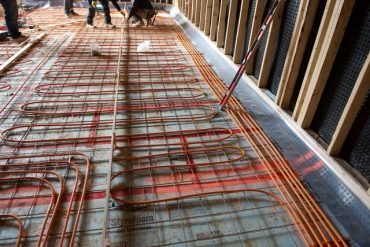Farewell Hydronic Floors
I hate to be the bearer of bad news for those of you who love hydronic heated floors, but in the not-so-distant future they won’t hold value.
No, it’s not the liberals coming to take your heated floors and no it’s not Alberta withholding oil so that “the Eastern bastards freeze in the dark”. It’s simply that as we get better and better at building high-performance homes they will not be economically justifiable.
Why Ben? Why?
I’m going to get a bit technical here but bear with me. People love hydronic heated floors because they love warm toesies.
In modern homes built and tested to high performance standards we simply don’t have enough heat loss through the building envelope. This is a good thing from an energy and economics perspective, but it means that you don’t have to put all that heat energy into the building to make up for what’s being lost. In my home province of BC we are implementing the BC Energy Step Code, and currently at step 3 province wide. As the years go on we will find less and less comfort benefits from installing hydronic.
Source: https://www.canadiancontractor.ca/canadian-contractor/radiant-floor-heating-always-best-choice/1003277762/
How does this change heated floors? Well, heated floors feel so warm in most buildings because maintaining a comfortable interior temperature means replacing the heat lost through the building envelope (exterior surfaces) with heat that radiates and conducts from the floor to the space. With air-tight construction and more efficient U-value assemblies (higher R-value) we lose significantly less heat to the exterior environment.
If you only need to add 10 000 BTU (just shy of 3 kW) of heat energy per hour to keep your room temperature comfortable in a high-efficiency home, whereas before the same home built to previous codes and not verified for airtightness required 5 kw, your floor will be at a drastically lower temperature to maintain that desired air temperature.
There is still a good argument for localized heated floors, say in your bathrooms or a tile kitchen. Personally, I would prefer these to be resistive heated with wire than hydronic from a cost and simplicity standpoint, but also because then they introduce one more backup heat redundancy for times of equipment failure. I also like avoiding unnecessary water lines whenever possible from a risk standpoint.
Your toesies will likely not notice the warmth.
This is a nice, clean set up, well done by a professional, and likely very pricey.
Source: https://www.canadiancontractor.ca/canadian-contractor/radiant-floor-heating-always-best-choice/1003277762/
Hydronic is Expensive
Whether it’s run from an air-to-water heat pump, boiler, or tank-based heater, the hydronic system still requires a lot of capital input.
Tubing, valves, pumps, equipment, LABOR. You are looking at likely $15-40k for the average home system. This doesn’t sound so bad until you realize that you still have to install a separate cooling system, which will likely be a heat pump, which is… let me check… ah yes here it is: Also capable of heating.
Sum it up for me, Energy Boy.
It’s your home. Do what you want. I support you.
As a designer of heating and cooling systems for homes and an energy advisor who despises wasting money, I would encourage you to have your building properly analyzed for energy and temperatures. My role is to design your building to be comfortable and maximize your return on investment while lowering your long-term energy costs.
These analyses often do not support an economic or comfort-based argument for installing hydronic in well-built homes in most climates any longer.



